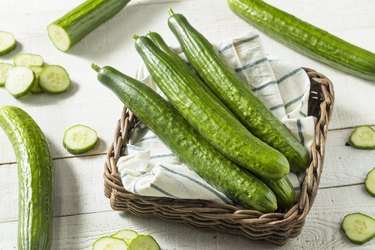
Things You'll Need
Rototiller or shovel and hoe
Aged compost
English cucumber seeds
Water
Knife
The cucumber is a warm-weather vegetable that grows easily in most home gardens. English cucumber is a thin-skinned variety commonly used in salads, as garnish or eaten by itself. This type of cucumber is much longer and slimmer than other varieties, and their skins are thinner. English cucumbers that are sold in stores are usually wrapped in plastic to protect their delicate skins. Growing English cucumbers in the home garden is as easy as growing any other variety.
Step 1: Prepare the Planting Site for Growing English Cucumbers
Prepare the soil by tilling well and removing all sprouting weeds from the area. Add aged compost and work it well into the soil. Till to a depth of at least 6 inches.
Video of the Day
Step 2: Sow the Seeds
Plant English seedless cucumber seeds after the last danger of frost has passed. Sow seeds in small hills 4 to 5 feet apart. Bury six seeds 1 inch deep in each hill. Nighttime temperatures should remain above 50 degrees Fahrenheit for cucumbers to grow well.
Step 3: Thin the Cucumber Seedlings
Thin the seedlings down to two or three per hill, keeping only the most vigorous plants. Take the discarded plants away from the garden area and destroy them to avoid pest and disease problems.
Step 4: Keep the Cucumber Plants Well Watered
Water the cucumber plants frequently. English cucumbers have shallow root systems and dry out quickly. Avoid overwatering; the soil should be moist, but not soggy. Increase the amount of water as the plants grow, since English cucumbers are mostly water and will grow best with adequate moisture.
Step 5: Watch and Treat for Cucumber Beetles
Check often for cucumber beetles, as these tiny pests spread bacterial wilt among cucumber plants. Control them when the plants are small or the entire crop can be lost. Spray with a vegetable-safe pesticide labeled for cucumber beetles, if necessary.
Step 6: Eliminate Yellowing Cucumbers
Remove any yellowing fruits immediately, as they will affect the quality of the others on the vine.
Step 7: Harvest Your English Seedless Cucumbers
Harvest English seedless cucumbers before they reach full maturity, for best texture and flavor.
Tip
English cucumbers can easily be trained to grow on a trellis to save space and to protect the cucumbers from problems caused by continued contact with the ground. Tie the plants up as the vines grow. Support them well, otherwise the weight of the fruit can cause the stem to break.
When harvesting English cucumbers, cut the stem just about the cucumber with a knife, instead of trying to break it off to avoid damaging the fruits during picking.
To get a head start on the growing season, start English cucumbers indoors in peat cubes. Transplant them to the garden once it is warm enough.
Warning
Poor pollination or lack of nutrients can cause English cucumbers to become deformed. Remove deformed cucumbers from the plant immediately, as they will not develop properly and will only serve to rob the perfect fruits of necessary nutrients.
Inconsistent watering – dry periods, then too much water – can result in plant problems and deformed fruit.
Video of the Day